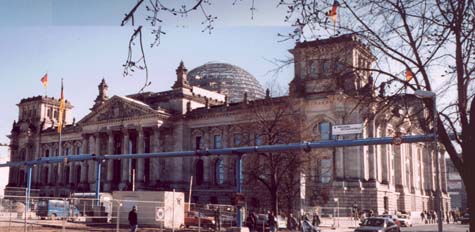 . . .
. . .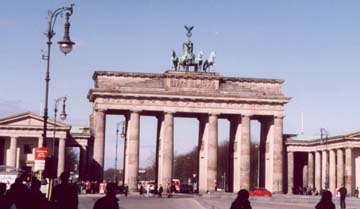
I spent 5 days sightseeing in Germany. There is quite a bit to see and I by no means saw very much. The first 4 days was spend on a DIS sponsored study tour I had signed up for. We left Copenhagen on a bus and travelled down to Berlin and was taken on a guided tour of the city and let to explore ourselves during the evening. Berlin was a very interesting city. Construction is quite common and looking over the skyline one sees more cranes than anything else, especially around the area where the Reichstag is located. One thing that surprised me, sice I hadn't really thought about it, was all the bullet holes left in many of the old buildings from WWII. Many churches, museums and government buildings that survived the war had spots where one could see it had been shot at and repaired. It brought quite a touch of realism to many of the history lessons I have had over the years. Below left is a picture I made from two pictures of the Reichstag, which is the main government building in Berlin. The inside was burned out by Hitler in his ascent to power in the 1930's. However it has been updated with a new modern interior. There is a glass elevator which leads up to the roof where one can walk up a spiral ramp inside of the large glass and steel dome which now sits on top of the building. From here one can see an excellent view of Berlin. As can be seen in the picture, there is much construction right in front of the Reichstag. the blue piping are water drain lines. Berlin is so low that when buildings are built, the water that comes up has to be continuously pumped out during construction. Below right is a picture of the Brandenberg Gate which separates the "east" from the "west". This picture was from the east side looking west.
 . . .
. . .
We also visited what little is left of the Wall. There are two small sections left of the wall that once divided this city. This is the better preserved section. Below left is a picture of what one saw on the west side of the wall. Below left is the end of this particualr section showing the cross section of it. It is not very high or thick as one might imagine or have seen on TV when it fell. The thickest and largest section was right around the Brandenberg Gate which was also a entry and departure place for people visiting the east.
 . . .
. . .
The below left picture is me in front of the wall and the below right is a simulated area of what it was really like behind the wall. This section of the wall has large iron walls on both ends and then a bunch of large chuncks of concrete stacked along the backside. The area in the middle is the general size that was usually patrolled during the time the east and west was divided. Usually dogs ran through here and would attack anyone found in here. Guards as well kept an eye on this and would shoot anyone found in here. The concrete on the backside had 1/2 inch cracks to look through to give one a good impression of what this bleak area looked like.
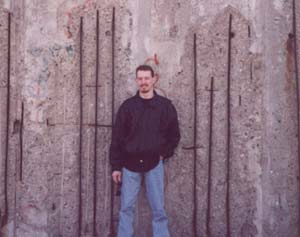 . . .
. . .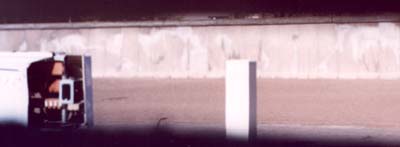
With Berlin once again becoming the Capitol of Germany many other changes are occuring. One is that all nations need to build new embassies in Berlin. The United States Embassy in Berlin is, at the moment, just an open plot of land. The Scandanavian countries were the first to build embassies. They decided to build them together in a complex surrounded by large copper rings. Pictured below is the Norwegian Embassy. The Stone in the front is carved from a single piece of granite that came from the side of a mountian in Norway. It is about 3 feet thick and quite tall as one can see. All the embassies here have quite interesting architecture that is different and unique for each Scandinavian country.
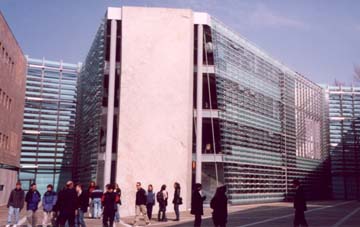

The last stop on our study tour of Berlin was the most horrific. It was the Sachsenhausen Memorial Camp. It served as a Nazi Concentration Camp during WWII. Then the Soviets used it as an Internment Camp from 1945 to 1950. To the right is a memorial erected by the Soviets to honor all the Soviets who died battling Germany. It is quite a large monument as can be seen by the size of the people in front of it. Below are two pictures of what has been reconstructed at the camp. Much of the camp has been destroyed. The picture on the left is looking at the main entrance gate. There is an grey area that comes out from the fence a ways. Any prisoner caught in here for any reason was shot immediately. Sometimes for fun guards would throw a prisoners hat or something into this area and command him to retrieve it, or he would be shot. If he did not he was shot. If he did, he was in the forbidden area and was shot. The picture on the right is a typical barracks where prisoners were kept. This one was a hospital barracks and the grey building is a "hospital". Most often this is where the gruesome medical experiments were carried out. Wives of the guards who ran the camp sometimes would see a tatoo on a prisoner they thought looked "pretty". In this hospital, the prisoner would be killed, the tatooed skin removed and tanned. Also any gold fillings would be removed. This was quite a gruesome and troubling building to be in. This camp also had a gas chamber but since it was not an Extermination Camp, it was not used to kill prisoners. I believe that the official recored is that the gas chamber at this camp was never used. Still due to cruel treatment, poor nutrition and other reasons, many thousands still died at this camp. Although not pleasant, this is something that everyone should see in their lifetime.
 . .
. .
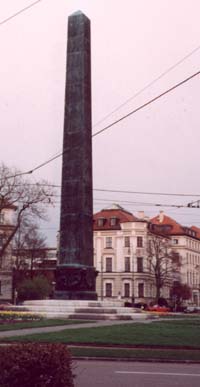
After berlin I traveled down to Munich. Unfortunately it was quite cold and rainy that day so I was unable to see as much as I had wanted. I did take a bus tour of Munich to see some of the most popular sites. The picture to the right is a memorial for something I cannot remember. I promised myself when I took this picture that I would remember it and I completely forgot. Once I find some time I will look it up and update this. The highlight of the bus tour was the Munich castle which was a very large wooden structure where Munich's Royal Family has lived. The first picture below is looking out from the front of the castle. There is the large pool in the middle of the front yard and the waterway leading straight away is outside the castle grounds. It is perfectly straight and has a roadway on either side of it. It runs for quite a ways and is a main street in this part of Munich. The two pictures below are the front and side of the castle. The main castle spreads out and then a smaller part encircles the front yard. The whole area is quite large. Inside the castle walls are adorned with paintings of all the Royal occupants of the estate and is well furnished with the most fancy woodwork and furniture imaginable.

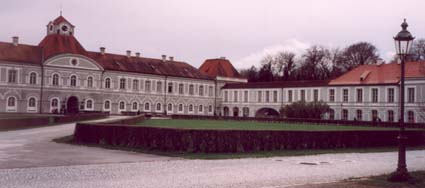 . .
. .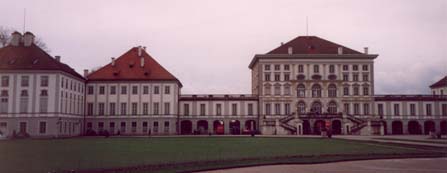
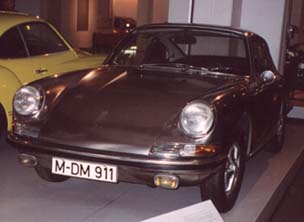
I also Visited the Technical Museum in Munich which is quite a showcase of German engineering and technical knowhow. To the right is a Porche 911 with the body made completely out of stainless steel. Although never put into production, this model was built to test the workability and feasibility of building a car like this. I guess it was not successful since you do not see stainless Porche's driving around. The two pictures below are of the German ME 262 jet developed near the end of WWII. I found it quite interesting that any Nazi insignias had been removed from the plane. Interesting technology but not a proud way for it to have been developed. The open engine is quite interesting to look at.
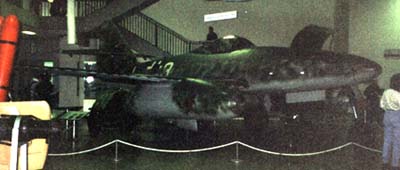 . .
. .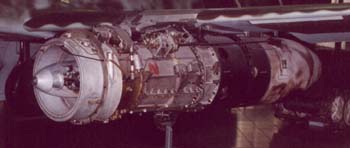
To finish off this page I have a picture of what the typical German coins look like. I tried to collect coins from every country I visited since this is one souviner that is genuine to each country. This should be all the German coins in use. One is of the front, the other the back.


This Page was last updated on 18 January 2001.
This page created and maintained by Garrett Robert Herning.